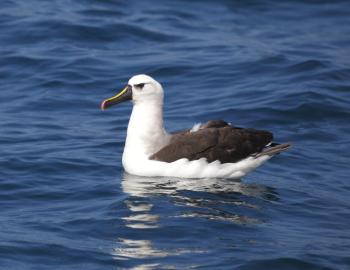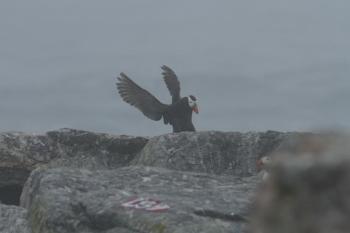Maine’s Record of Rare Birds Continues
Maine gets a good share of very rare birds. Some of them keep coming back.
Over the past few weeks, Maine’s ocean and offshore islands have played host to at least two exceptionally unusual species. We’ve written about one of them, the tufted puffin, before. This dramatic black seabird with a white face and orange puffin bill is normally found nowhere else but the Pacific Coast of North America.
Yet, like the famed Steller’s sea-eagle, a single tufted puffin has found its way to the Maine coast, where it appeared last year at several Atlantic puffin colonies. This year, the bird (at least, we have a strong presumption that it is the same bird) has been seen a number of times at Eastern Egg Rock by the Audubon staff stationed there, off of New Harbor, as well as at several other islands in the Gulf of Maine. Sadly, we have missed it on our trips to Eastern Egg so far this summer.
Another rare summer visitor this year is a classic bird of many of the world’s oceans except for our own North Atlantic. The bird? The famed albatross. Very, very occasionally, an albatross crosses the equator and makes it way into the waters of the Atlantic. Here in Maine, there are only a handful of confirmed sightings of albatrosses since the 1960s: one of the black-browed albatross, and seven of the South Atlantic yellow-nosed albatross.
Not only is the yellow-nosed albatross rare in Maine, but it is globally endangered because its small total population size is experiencing declining numbers. The species nests primarily on six islands in the Sub-Antarctic between South America and South Africa.
On the afternoon of July 8th, a group of birders on the Cap’n Fish whale watching boat out of Boothbay Harbor saw a very large bird sitting on the water ahead. With its six-and-a-half-foot wingspan, It didn’t take them long to realize it was a yellow-nosed albatross. They convinced the captain to carefully approach closer and obtained stunning photographs to confirm an eighth record of this beautiful and special species for Maine.
A search of eBird records showed that the closest other sighting of a yellow-nosed albatross this year was off Rio de Janeiro in Brazil, over 5,000 miles away! That bird has got to be pretty lonely—well, about as lonely as that tufted puffin and that Steller’s sea-eagle.
It's impossible to know what causes any of these birds to end up so far from the rest of their kind. Does the changing climate and its warming impacts on land and sea that ripple through the food chain have anything to do with it? Or are these just the few in every population that make a mistake during migration, or get caught in a storm, or just travel to the beat of a different drummer?
Whatever it is, their presence makes the lucky few who see them feel blessed and connected to the far-away places they come from.
Jeffrey V. Wells, Ph.D., is a Fellow of the Cornell Lab of Ornithology and Vice President of Boreal Conservation for National Audubon. Dr. Wells is one of the nation's leading bird experts and conservation biologists. He is a coauthor of the seminal “Birds of Maine” book and author of the “Birder’s Conservation Handbook.” His grandfather, the late John Chase, was a columnist for the Boothbay Register for many years. Allison Childs Wells, formerly of the Cornell Lab of Ornithology, is a senior director at the Natural Resources Council of Maine, a nonprofit membership organization working statewide to protect the nature of Maine. Both are widely published natural history writers and are the authors of the popular books, “Maine’s Favorite Birds” (Tilbury House) and “Birds of Aruba, Bonaire, and Curaçao: A Site and Field Guide,” (Cornell University Press).






























